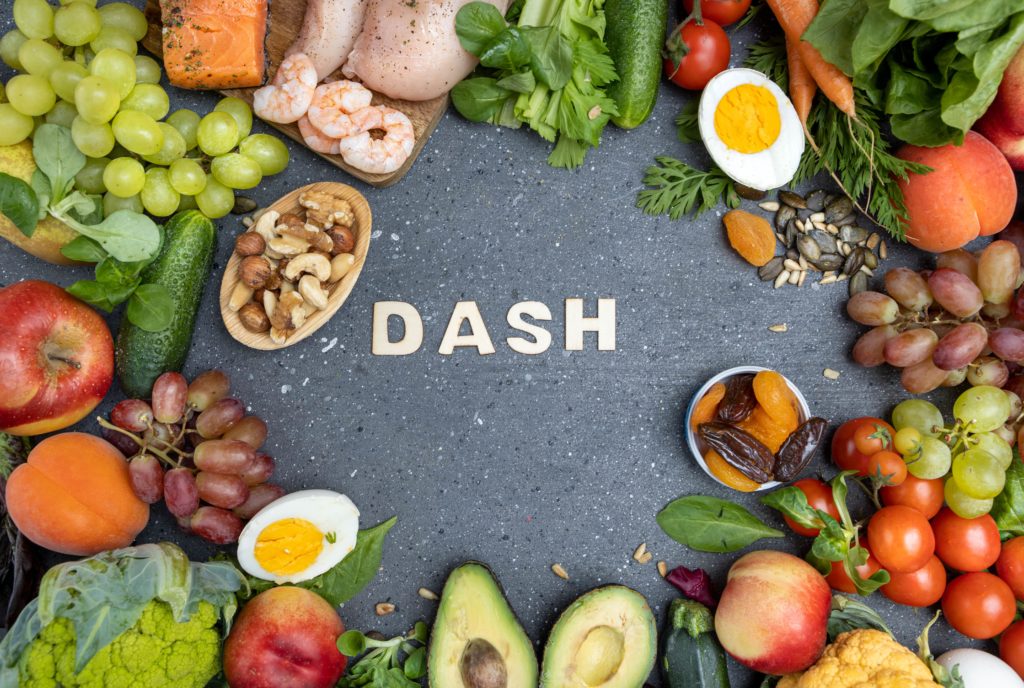DASH Diet and Cardiovascular Disease

Some suggestions on how to get started:
- Aim to fill half your plate at lunch and at dinner with a variety of vegetables that range in different colours (reds, oranges, yellows, purples, greens), this will help to increase your nutrient, vitamin and fibre intake. Let’s start by adding 3 different types of vegetables and at least 2 portions of fruit per day for this month.
- Swap the type of carbohydrates you eat, refined carbohydrates such as white bread and white rice should be swapped for whole grain alternatives (whole wheat/brown) and swap full-fat dairy for low fat dairy options.
- Consume oily fatty fish 2 to 3 times a week, include fish such as salmon, herring, and mackerel and reduce your intake of red meat (e.g. beef and lamb) and processed meats (e.g. sausages, salami and nuggets) to only once a week.
- Use extra virgin olive oil to drizzle onto salads, replacing other oils and butter. Include nuts and seeds as either a snack or on top of meals.
- Limit your daily intake of salt to no more than 1 teaspoon (2,300 mg) a day. Check the food packages before you buy a food and ensure that the sodium/salt content in either in the green traffic light system. Foods such as bread and breakfast cereals can contain a high amount of salt.
DASH Diet & Cardiovascular Disease: The Key Points
- With every heartbeat, blood is pumped around your body to supply it with energy and the oxygen it needs to function and keep you alive. In order for this blood to be pumped out and around your body it needs a force. This force is measured as blood pressure.
- Blood pressure is recorded with 2 numbers, the systolic pressure and the diastolic pressure. The systolic pressure is the higher number and is the force at which your heart pumps blood around your body. The diastolic pressure is the lower number is the resistance to the blood flow in the blood vessels. Both these measurements are measured in millimeter of mercury (mmHg).
- High blood pressure (medical term: hypertension) is known as “The Silent Killer” is one is the biggest risk factors to your cardiovascular health. It is often related to unhealthy lifestyle habits such as smoking, drinking too much alcohol, an unhealthy diet and being inactive. High blood pressure is considered to be 140/90 mmHg or higher. Ideal blood pressure is considered to be between 120/80mmHg and 90/60 mmHg.
- The most scientifically effective dietary intervention you should be on to reduce your blood pressure is the DASH Diet (Dietary Approaches to Stop Hypertension)1. The DASH diet it not limited to just health benefits for your heart’s health but also will improve your overall health and reduce your risk to other chronic diseases including certain types of cancer2 and type 2 diabetes3.
- This way of eating emphasizes upon a diet rich in fresh fruits, vegetables and low-fat dairy products, including whole grains, lean animal meats (chicken, turkey), fish and nuts4.
- The DASH diet recommends a low intake of red meat, added sugar commonly found in processed foods, saturated fat and includes no more than 1 teaspoon of salt intake per day.
References:
- Appeal, L.J., Moore, T.J., Obarzanek, E., Vollmer, W.M., et al. (1997). “A Clinical Trail of the Effects of Dietary Patterns on Blood Pressure.” The New England Journal of Medicine. 336(16): 1117-24.
- Onvani, S., Haghighatdoost, F., and Azadbakht, L. (2015). “Dietary approach to stop hypertension (DASH): diet components may be related to lower prevalence of different kinds of cancer: A review on the related documents.” Journal of Research in Medical Sciences. 20(7): 707-713.
- Campbell, A.P. (2017). “DASH Eating Plan: An Eating Pattern for Diabetes Management.” Diabetes Spectrum. 30(2): 76-81.
- Bazzano, L.A., Green, T., Harrison, T.N., and Reynolds, K. (2015). “Dietary Approaches to Prevent Hypertension.” Current Hypertension Reports. 15)6): 694-702.